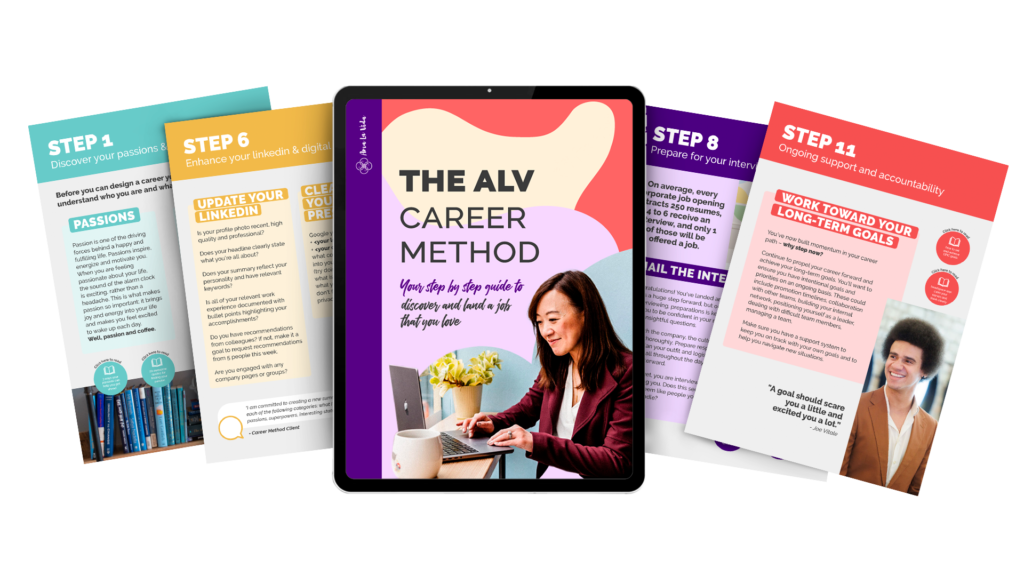PIVOT! 10 Steps to Making a Career Change

Let’s face it, changing careers can be scary! But did you know that the average person spends 90,000 hours at a job? If you’ve been unhappy at work, sticking it out won’t get you a medal. Instead it can lead to frustration and burnout.
Changing careers can be scary or overwhelming, especially if you’ve been in your current job for a long time, but we’re here to give you a concrete action plan to help you get started.
Let’s dig into how to change to a career that makes those 90,000 hours go by a little smoother.
How did we get here?
Have you been thinking “I need a new career!” but feel stuck?
You’re in good company—Oracle did a study that found that 75% of people feel stuck in their current job.
There could be several reasons for feeling stuck. Maybe someone talked you into pursuing the career path you’re currently on. Maybe you were enticed because it was prestigious. Maybe you were already on the path and didn’t realize that you didn’t want it until it was “too late. Maybe the problem is just your current situation with a bad boss or bad culture. Maybe it’s just the wrong fit.

There could be a myriad of reasons for this, but let’s face it, you need a change.
Our career transition process
Ama La Vida helps those who are looking for a career change from their current job. They have amazing coaches across numerous industries who will walk with their clients to help them determine their next career move. And it doesn’t hurt that they break it down into 10 easy steps to help their clients with this process that could feel daunting alone.
10 steps to make a career change
Starting a career transition can feel like a really big change.
This article will give you an overview of The Ama La Vida Career Method process, which walks you through 10 steps in a way that doesn’t feel overwhelming.
Our process starts with you as the foundation to determine where to look, and then sees what careers lineup with you. Then we’ll walk you through specific steps to land a new role that aligns with who you are.
We also have a team of career coaches who can help by coaching, providing resources, and creating action plans that move you toward your new career path.
Ready? Let’s go!

Step 1: Passions and gifts
Let’s start easy: what do you like and what are you good at?
The first step to determining your next career is identifying your passions and your gifts.
Explore your passions
When you think about your passion, think about what lights you up at work? Where do you lose track of time? What are you interested in doing or learning more about? These are your work passions that bring you energy.
Identify your gifts
When you think about your gifts, think about what comes naturally to you?
What do others compliment you on? Where does your expertise shine? These are your gifts and skills that you bring to the table. Don’t rush this self-assessment – these are the things that you will likely want in your next role.
Step 2: Values and purpose
The next steps of this self-discovery portion are determining what your values are and what your purpose is.
Define your values
When you think about your values, think about the pillars that you need – if one of these pillars was missing, the house would not stand. You can usually determine what a value is by how you react when that value is violated.
For this one, what are the areas of your life that are vital to your happiness or key to your view of the world? This might be family, endurance, loyalty, or grace.
Name your purpose
A purpose can feel like a very lofty thing, but let’s break it down.
Ask yourself, what problem would you like to solve at work? What kind of impact do you enjoy making? What brings you that feeling of success?
Use these answers as your starting point to determine what impact you’d like to make in your next role (your work purpose).

Step 3: Explore and understand your options
Once you’ve laid your foundation that is based on YOU, then you begin to explore your options in finding a new career.
Brainstorm career options
Start out by making a list of potential jobs. Go through each of the previous categories of personal traits you listed in steps 1 and 2, and write down every possible idea related to each of these.
Keep an open mind and come up with a list of potential options – this is where we cast a wide net.
Don’t forget to ask others for ideas and advice. Be sure to get input from those who know you best. Ask them what roles they think you’d be good at and why. When making this list, you can even think of roles you’ve previously worked to gather more ideas of what you want.
Once you have that long list, you’ll want to narrow it down. Bring in your gifts, passions, values, and purpose to determine what is a good fit and what isn’t. Remember, you want to find a job that’s a good fit for YOU, not the other way around.
Once you’ve created your list, you’ll want to understand the roles on your list. You should be able to answer what a day in the life is actually like and what the daily tasks and responsibilities are. You can do this by doing your research to learn the ins and outs of these jobs, asking for information interviews, etc. You’ll also want to fully understand the requirements. What training is required? Will you need to learn a new technology or obtain additional education? Will you have to go back to college, take new courses, or get your MBA/Master’s degree? And most importantly: are you willing to do that? These are all important questions to ask before making a switch and finding a new career.
Step 4: Define your optimal career path
Now that you have a list of roles, write out your non-negotiables.
These aren’t your “nice to have” pieces. Instead, these are things that you HAVE to have in order to be happy. These are your priorities. Non-negotiables to consider would be commute, money, opportunities for growth, flexibility, travel, benefits, stability, variety and more.
Write these non-negotiables out and compare them with the list of job ideas you created in the previous step. This will help you narrow down the list to just a few options you want to explore further.
Step 5: Revamp your resume
Now that you know the direction of your career change, let’s talk about how to make this transition happen! First thing is first, your resume.
TheLadders conducted a quantitative study of recruiters that found recruiters are skimming an initial resume for ~7.4 seconds to determine if they want to bring a candidate in. So essentially, you have 7 seconds to impress! This is NOT a summary of your experience. Your resume is a marketing tool, a sales pitch as to why you’re the perfect person for the job.
Here’s how it works:
Start with the job description and work backwards
- I like to have my clients put the job description in a word document (or feel free to print it out) and highlight the keywords you see in the posting.
- After that, circle the skills that you can speak to or demonstrate. You definitely want those highlighted, circled words on your resume – it’s important to use lingo that employers use and understand.
- Now, use those words to rewrite what you’ve accomplished in your previous work experience.
Here are a couple of other tips:
- The summary statement at the top of your resume is important since it is likely the first thing employers will read.
- You want your bullets to be as meaningful as possible in telling your story, in a succinct way. It’s not about sharing everything you’ve done in your current position – keep it relevant to the job you are applying for.
- Be sure you are quantifying impact rather than just putting numbers in for numbers sake. If you completed a big project, talk about it! Why was that important for this new job that you’re applying to?
- While it may feel strange to toot your own horn, this is the time to do so! Stretch yourself and acknowledge your contributions and skills.
Online applications for jobs go into an application tracking system (ATS). Most companies use these to screen the resumes before looking at them. That means that if you’re not getting call backs, make sure your resume is formatted in an agreeable way, includes relevant keywords and skills, and is uploaded via pdf (or Word if requested).
So when it comes to the ATS, know that they exist, how they work, and that you still need to be reaching human beings.
Step 6: Refresh your LinkedIn profile and digital presence
According to Jobscan, 94% of all recruiters and hiring managers utilize LinkedIn. This should tell you that your LinkedIn and online presence is important. Reflect on your personal brand and the vibe you want to portray. This should be the story you tell throughout your LinkedIn profile. Don’t forget to look at your profile through the lens of the recruiter who is going to hire you for your new job.
You’ll want to add keywords into your Headline as well as your About section. You can have bullets or blurbs in your experience section as long as they are consistent. And don’t forget to add in your skills!
Oh, and you can indicate that you are job searching on your profile. Don’t worry, there is a setting that allows only recruiters to see this.
Step 7: Apply and network
Networking is an important part of the job search process. Making connections can be the difference between an endless, frustrating job search and getting a quick call back.
LinkedIn is a wonderful place to start. Reach out to others in your industry, and make sure to find people at the companies where you’ve applied.
You can register for events, go to a conference, sign up for a free certification, or just strike up a conversation with a friend to see if there is anyone in their network that aligns with your interests and what you’re looking for. You can also check out this blog that digs into mastering the art of networking.

Step 8: Prepare for interviews
Interviewing can be nerve-wracking, but it doesn’t have to be. Let’s talk about interviews and hopefully calm those fears just a little.
There are 3 types of interview questions: introductory questions, behavioral questions, and open ended questions.
Prepare for introductory questions
These are just questions used to get to know you. You know yourself best, so simply communicate your story!
Prepare for behavioral questions
These are the “tell me about a time when…” questions. For behavioral questions, it’s helpful to use the STAR method. Here is how it works:
- S – Describe the event or situation.
- T – Explain the task you had to complete.
- A – Describe the specific actions you took/skills you used.
- R – Describe the results of your efforts.
Prepare for open-ended questions
For open-ended questions (like, what are your biggest strengths), use the rule of 3’s: Give 3 blurbs with a little detail. It ensures you have enough depth to your answer without going on and on and on.
Prepare, do your research, and practice your responses (hint: saying your responses out loud is proven to help with those nerves).
Don’t forget that you’re interviewing these companies, too. You want to get a good feel for the role, but also the culture of the company before you decide to accept an offer.
Step 9: Negotiate
Far fewer people negotiate than you would expect. Even though most people get something better than what they had if they hadn’t asked in the first place, even if it isn’t exactly what they want. It’s easy to be worried that you’ll come across as ungrateful or that they will rescind the offer.
Please know this is not standard practice, and, frankly, it is a sign that this might not be the type of company you want to work for anyway.
Factors to consider when you negotiate are:
- Average salary for these types of roles.
- How your experience stacks up against others.
- The average cost of living for where you live.
- Additional credentials, skills, or previous responsibilities.
When you negotiate, it’s imperative to talk about what you bring to the table, but it’s also important to note and reiterate your interest in the role.
Step 10: Day 1 and beyond
Congratulations – you’ve landed your dream job! We want to make sure you are successful from day one on the new job, so we recommend a couple of things for our clients:
- Make a 90-day plan to start off on the right foot.
- Get clear on responsibilities and expectations for your role and what success looks like.
- Network internally. Don’t stop networking once you land your role. It’s important to continue this practice so you are constantly preparing for the next phase of your career goals.
- Keep on learning. Read books and news about your industry, and ask about additional industry training that your new company offers. These are all things that will build up your skills in your field and help you ramp up as quickly as possible.
Getting started
Changing a career can be really daunting. And while it’s easy to break everything down into 10 simple steps, sometimes you need a partner in this career process.
Finally, don’t get overwhelmed trying to do this alone. Book a free consultation call to learn about working with a career coach to achieve your career goals.








